Experimental Study of Electromagnetic Interference from Concentrated Discharge Channels within the Soil to Adjacent Directly Buried Cables during Lightning Current Inflow to the Ground
Abstract
:1. Introduction
2. Scaled Experiment Design
2.1. The Experiments in SEGM
2.2. The Experiments in DEGM
3. Discussion
3.1. Results in SEGM
3.1.1. The Influence of Discharge Channel Structure on Capacitive Coupling Current
3.1.2. The Influence of the Water and Salt Content on the Capacitive Coupling Current
3.2. Results in DEGM
3.2.1. The Influence of the Discharge Channel Structure on the Inductive Coupling Current
3.2.2. The Influence of Water and Salt Content on the Inductive Coupling Current
4. Conclusions
- 1.
- The coupling pattern in the shielding layer current is dependent on cable shielding layer grounding modes: the capacitive coupling current is the main component of the shielding layer current in SEGM, while the shielding current is composed of capacitive coupling and inductive coupling in DEGM.
- 2.
- When the cable is single-ended grounded, the capacitive coupling current is dependent on the distance between the geometric center of the discharge channel and the buried cable. The capacitive coupling current increases with the decrease in the distance, resulting in a difference of about 2.5 times the current amplitude. The water content and salt content will have an influence on the capacitive coupling process by affecting the dielectric constant and soil resistivity. The current decreases first and then increases with the increase in water and salt.
- 3.
- For magnetic field coupling (the inductive coupling current), the discharge channel will have an influence on the inductive coupling process by affecting both the distance and angle between the discharge channel and cable shielding layer circuit. The water content and salt content hardly affect the amplitude of the inductive coupling current.
- 4.
- The water content, the salt content, and the relative position of the discharge channel and the cable will affect the coupling current on the cable shielding layer. The influence of the water content and salt content on the capacitive coupling current is nonlinear, and they have little effect on the inductive coupling current. Therefore, it is not recommended that the electromagnetic interference of the cable be weakened by regulating the water content and salt content. The distance between the channel and cable and the relative direction of the cable or the cable-grounding device circuit will significantly affect the shielding coupling current. Therefore, it may be a better way of weakening the electromagnetic interference by setting an asymmetric grounding device or reducing the resistance of the soil in a specific area to induce the development direction of the discharge channel, thereby weakening the electromagnetic interference.
Author Contributions
Funding
Data Availability Statement
Conflicts of Interest
References
- Cooray, V.; Rubinstein, M.; Rachidi, F. Field-to-transmission line coupling models with special attention to the Cooray–Rubinstein approximation. IEEE Trans. Electromagn. Compat. 2021, 63, 84–493. [Google Scholar] [CrossRef]
- Zhang, Y.; Liao, C.; Shang, Y.P.; Du, W.; Huan, R.; Ye, Z.H. Analysis of the field-line coupling of the transmission line above an orthogonal ground plane through electromagnetic reciprocity theorem. IEEE Trans. Electromagn. Compat. 2020, 62, 580–588. [Google Scholar] [CrossRef]
- Liu, Z.R.; Cui, Y.G.; Zhang, B.; He, J.L. Measurement of multipath transients in secondary cables near a 500 kV gas-insulated switchgear during operations. IEEE Trans. Power Del. 2023, 38, 917–925. [Google Scholar] [CrossRef]
- IEEE Std 80-2013 (Revision of IEEE Std 80-2000/Incorporates IEEE Std 80-2013/Cor 1-2015); IEEE Guide for Safety in AC Substation Grounding. IEEE: Minneapolis, MN, USA, 15 May 2015; pp. 1–226.
- Liew, A.C.; Darveniza, M. Dynamic model of impulse characteristics of concentrated earths. Electr. Eng. Proc. Inst. 1974, 121, 123–135. [Google Scholar] [CrossRef]
- Geri, A. Behavior of grounding systems excited by high impulse currents: The model and its validation. IEEE Trans. Power Del. 1999, 14, 1008–1017. [Google Scholar] [CrossRef]
- Gao, Y.Q.; He, J.L.; Zou, J.; Zeng, R.; Liang, X. Fractal simulation of soil breakdown under lightning current. J. Electrost. 2004, 61, 197–207. [Google Scholar] [CrossRef]
- Zeng, R.; Gong, X.H.; He, J.L.; Zhang, B.; Gao, Y.Q. Lightning impulse performances of grounding grids for substations considering soil ionization. IEEE Trans. Power Del. 2008, 23, 667–675. [Google Scholar] [CrossRef]
- Rakov, V.A.; Uman, M.A.; Rambo, K.J.; Fernandez, M.I.; Fisher, R.J.; Schnetzer, G.H.; Thottappillil, R.; Eybert-Berard, A.; Berlandis, J.P.; Lalande, P.; et al. New insights into lightning processes gained from triggered-lightning experiments in Florida and Alabama. J. Geophys. Res. Atmos. 1998, 103, 14117–14130. [Google Scholar] [CrossRef]
- Rakov, V.A. Triggered Lightning; Springer: Dordrecht, The Netherlands, 2009; pp. 40–47. [Google Scholar]
- Sima, W.X.; Luo, D.H.; Yuan, T.; Liu, S.W.; Sun, P.T. Study on the image observation method and characteristics of soil discharge process under multiple impulse currents. IEEE Trans. Power Del. 2018, 33, 2125–2134. [Google Scholar] [CrossRef]
- Luo, D.H.; Sima, W.X.; Yuan, T.; Sun, P.T.; Chen, W.; Wang, J. Influence-factor analysis and parameter calculation of soil discharge and recovery characteristics under successive impulse currents. IEEE Trans. Power Del. 2019, 34, 514–523. [Google Scholar] [CrossRef]
- Wang, J.P.; Liew, A.C.; Darveniza, M. Extension of dynamic model of impulse behavior of concentrated grounds at high currents. IEEE Trans. Power Del. 2005, 20, 2160–2165. [Google Scholar] [CrossRef]
- Mousa, A.M. The soil ionization gradient associated with discharge of high currents into concentrated electrodes. IEEE Trans. Power Del. 1994, 9, 1669–1677. [Google Scholar] [CrossRef]
- Mazzetti, C.; Veca, G.M. Impulse behavior of ground electrodes. IEEE Trans. Power Appar. Syst. 1983, 102, 3148–3154. [Google Scholar] [CrossRef]
- Colominas, I.; Navarrina, F.; Casteleiro, M. Analysis of transferred Earth potentials in grounding systems: A BEM numerical approach. IEEE Trans. Power Del. 2005, 20, 339–345. [Google Scholar]
- Nahman, J.M. Earthing effects of uncoated underground cable and transferred potentials. Electr. Eng. 1996, 79, 55–60. [Google Scholar] [CrossRef]
- Vance, E.F. Coupling to Shielded Cables; John Wiley & Sons: New York, NY, USA, 1978; pp. 1–183. [Google Scholar]
- Zhang, G. Analysis of Coupling Function from External Transient Electromagnetic Field to Shielded Cables. Master’s Thesis, Harbin Institute of Technology, Haerbin, China, 2009. [Google Scholar]
- Li, B. Analysis on Interference Coupling Characteristic of Cable in Seconary of Substation Due to Lightning Impulse. Master’s Thesis, Shenyang University of Technology, Shenyang, China, 2014. [Google Scholar]
- Tatematsu, A.; Rachidi, F.; Rubinstein, M. Three-dimensional FDTD based simulation of induced surges in secondary circuits owing to primary circuit surges in substations. IEEE Trans. Electromagn. Compat. 2021, 63, 1078–1089. [Google Scholar] [CrossRef]
- Haddad, F.; Bayard, B.; Sauviac, B. Low-frequency relation between transfer impedance and shielding effectiveness of braided cables and grid shields. IEEE Trans. Electromagn. Compat. 2020, 62, 2423–2430. [Google Scholar] [CrossRef]
- Zhang, B.; Li, C.R.; Liu, Z.R.; He, J.L. Analysis of Transient in Secondary Cable Due to a Direct Lightning Strike on Grounding Grid. IEEE Trans. Electromagn. Compat. 2023, 65, 1183–1190. [Google Scholar] [CrossRef]
- Yeung, C.K.; Wang, J.G.; Zhou, M.; Zhao, W.H.; Huang, W.X.; Cao, J.X.; Cai, L.; Du, Y.P. Affection of shielding methods on the characteristics for cable coupled to lightning impulse magnetic field. Electr. Power Syst. Res. 2023, 226, 109802. [Google Scholar] [CrossRef]
- Liu, S.W.; Sima, W.X.; Yuan, T.; Luo, D.H.; Bai, Y.; Yang, M. Study on X-ray imaging of soil discharge and calculation method of the ionization parameters. IEEE Trans. Power Del. 2017, 32, 2013–2021. [Google Scholar] [CrossRef]
- IEEE Standard 1100-1999; Recommended Practice for Powering and Grounding Electronic Equipment. IEEE: New York, NY, USA, 22 March 1999; pp. 1–408.
- Royer, C.; Dorison, E.; Anderson, N.; Benato, R.; Brijs, B.; Chang, K.W.; Falconer, A.; Fernandez, S.; Gudmunsdottir, U.S.; Li, J.; et al. Cable Systems Electrical Characteristics; Technical Report for CIGRE Technical Brochure N°531; CIGRE: Paris, France, 2013. [Google Scholar]
- ASTM G57-06; Standard Test Method for Field Measurement of Soil Resistivity Using the Wenner Four-Electrode Method. ASTM International: West Conshohocken, PA, USA, 2012.
- Sima, W.X.; Liu, S.W.; Yuan, T.; Luo, D.H.; Wu, P.; Zhu, B. Experimental study of the discharge area of soil breakdown under surge current using X-ray imaging technology. IEEE Trans. Ind. Appl. 2015, 51, 5343–5351. [Google Scholar] [CrossRef]
- Zhang, P. Analysis to Effects of Main Factors on Dielectric Properties of Soil. Master’s Thesis, Northwest A&F University, Xianyang, China, 2013. [Google Scholar]
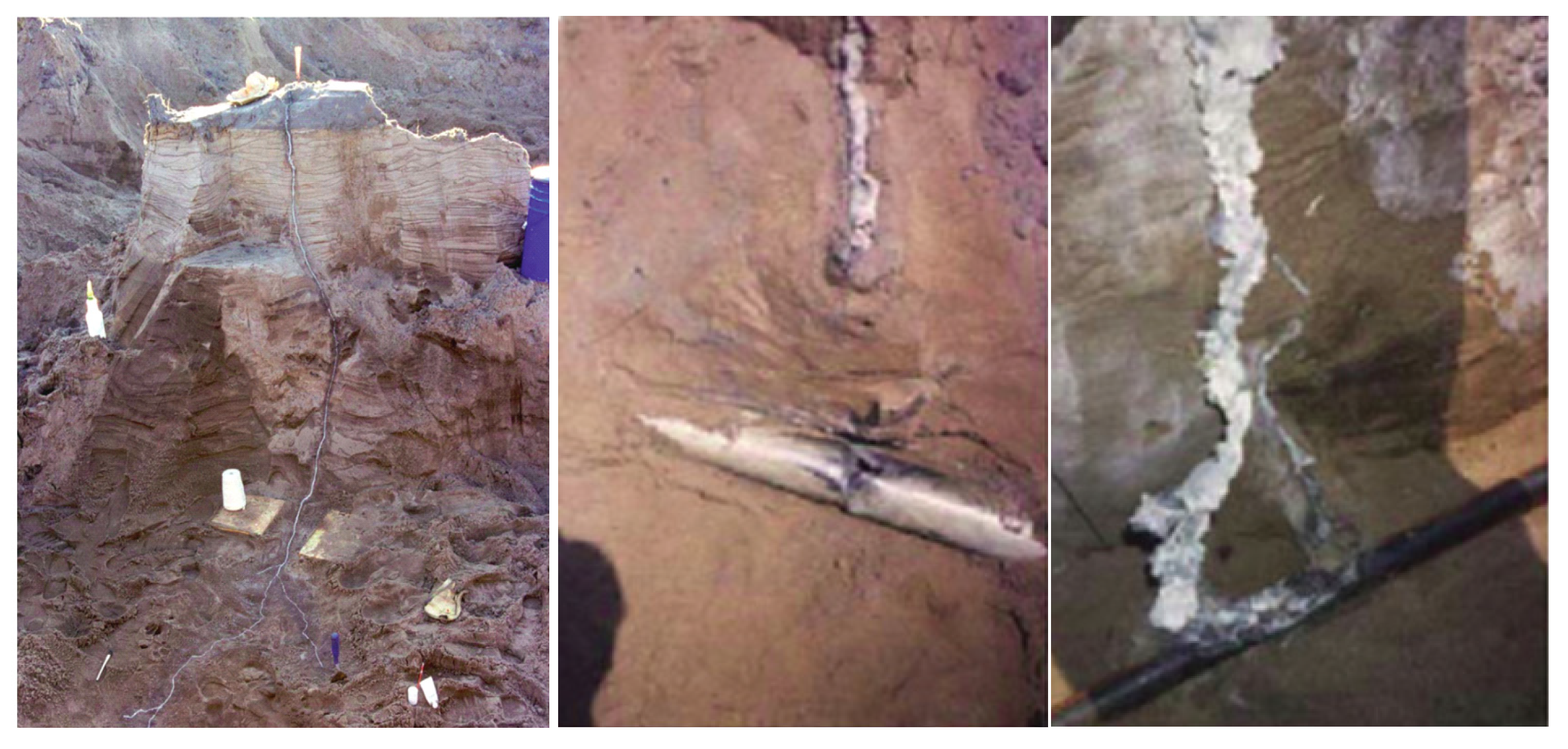





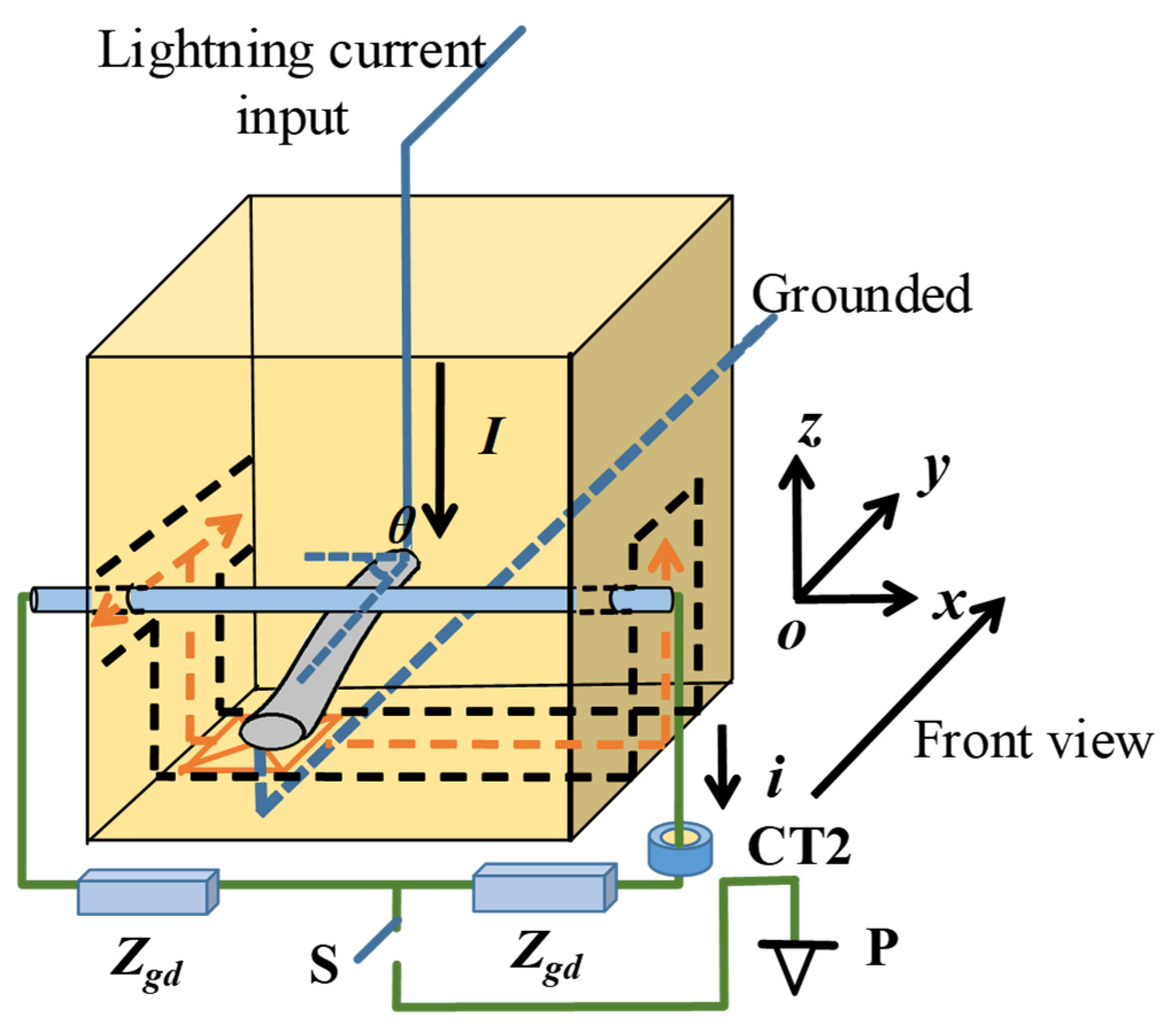


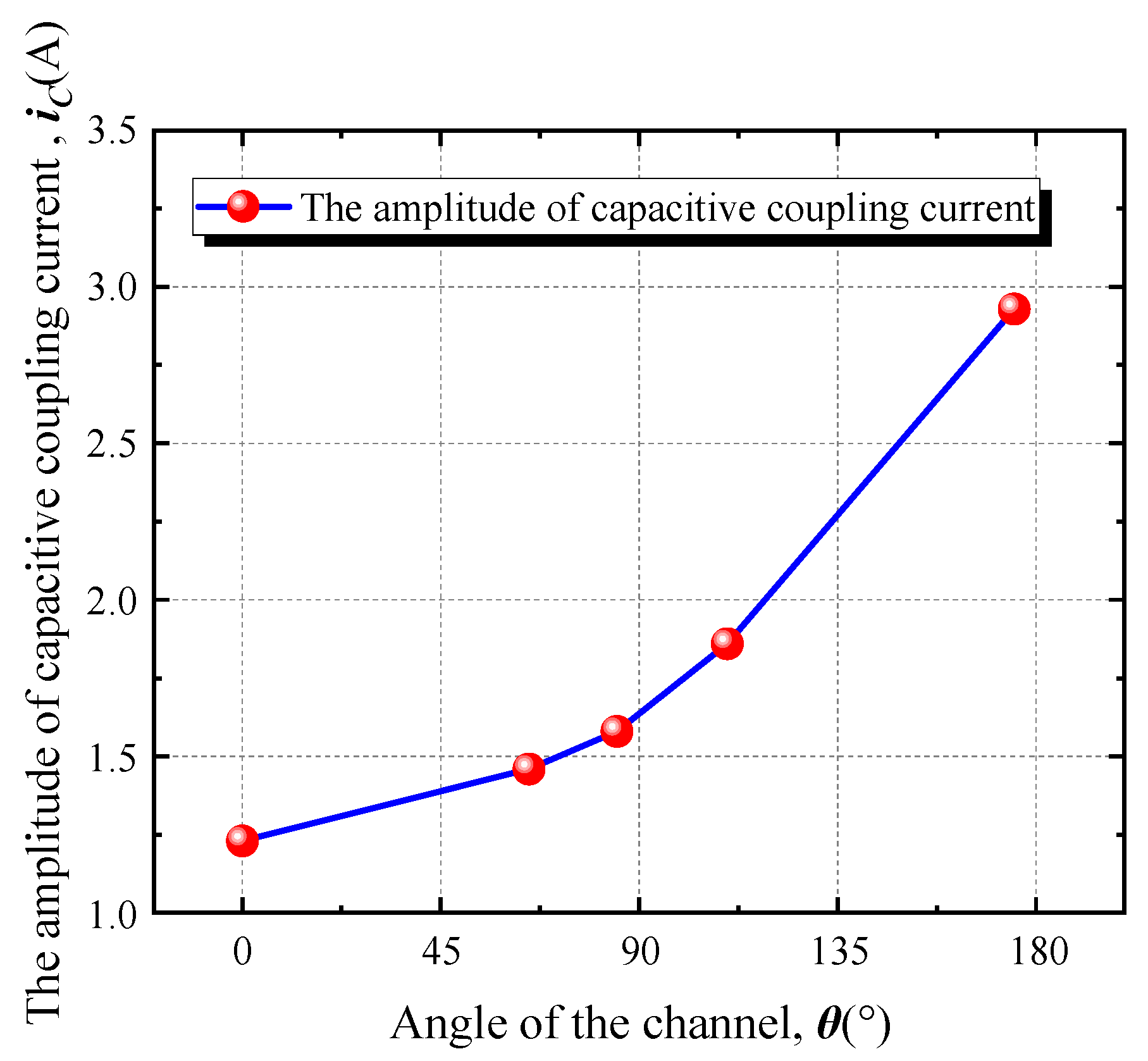

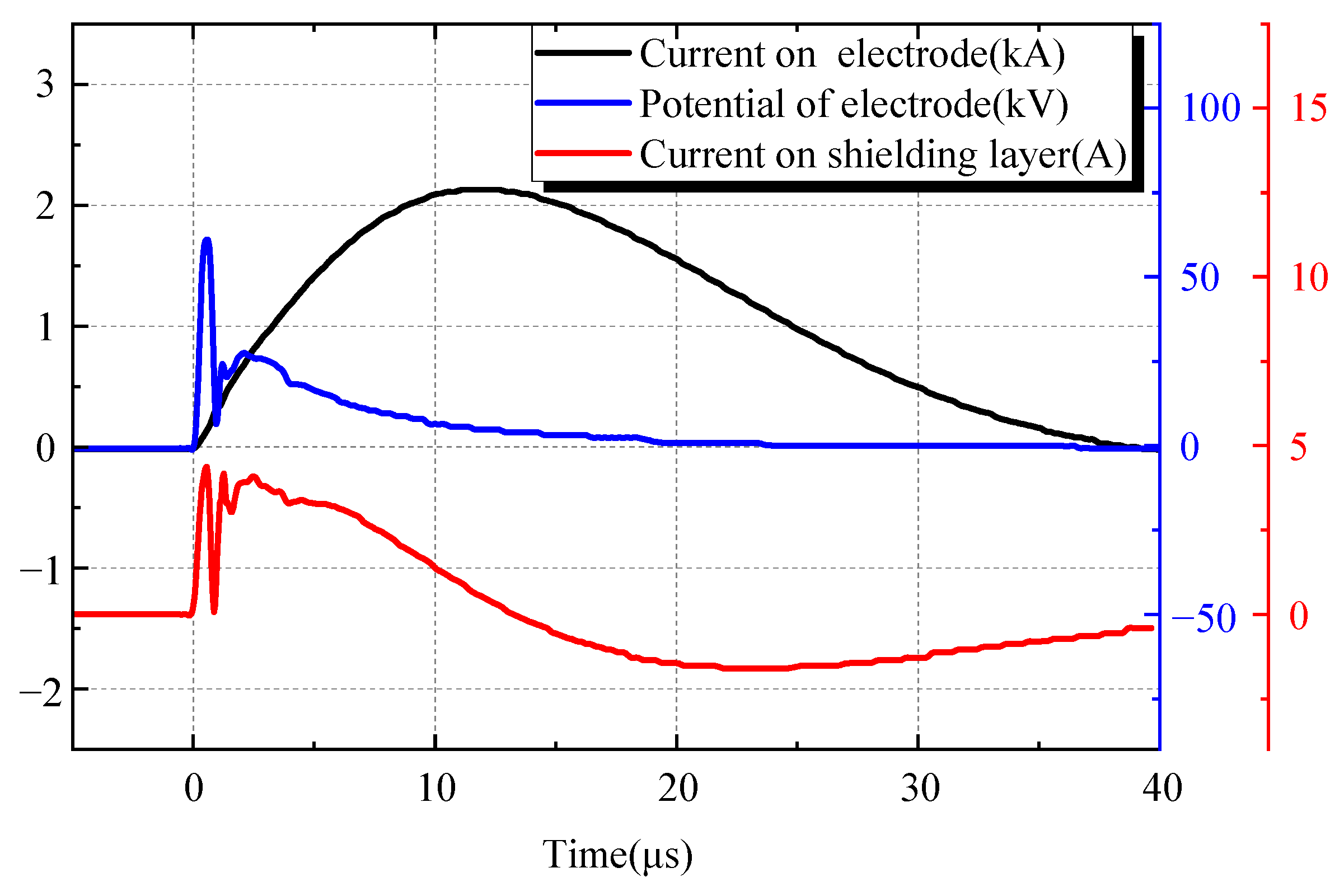





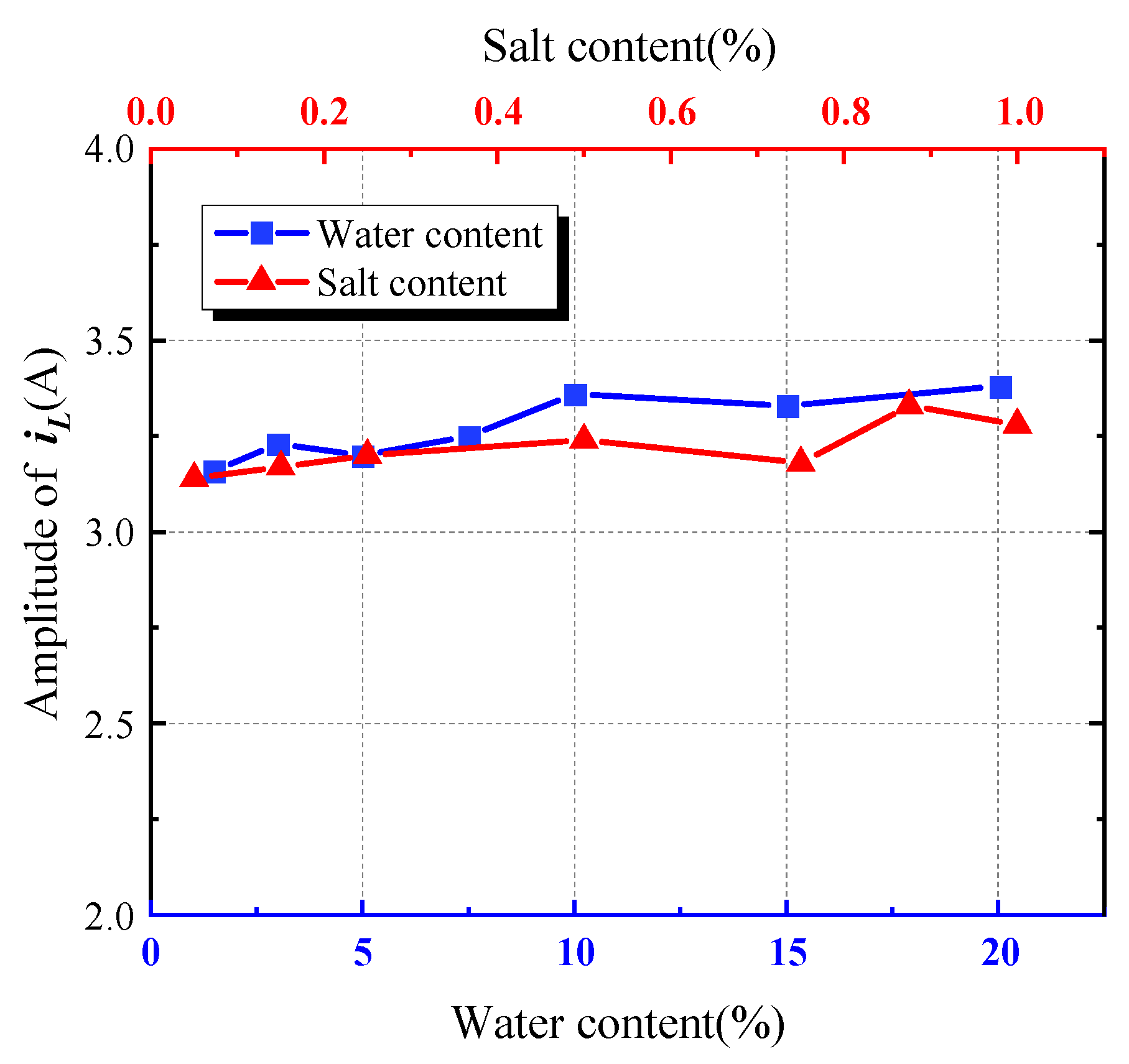
Disclaimer/Publisher’s Note: The statements, opinions and data contained in all publications are solely those of the individual author(s) and contributor(s) and not of MDPI and/or the editor(s). MDPI and/or the editor(s) disclaim responsibility for any injury to people or property resulting from any ideas, methods, instructions or products referred to in the content. |
© 2024 by the authors. Licensee MDPI, Basel, Switzerland. This article is an open access article distributed under the terms and conditions of the Creative Commons Attribution (CC BY) license (https://creativecommons.org/licenses/by/4.0/).
Share and Cite
Yuan, T.; Chen, Q.; Fan, R.; Zeng, W. Experimental Study of Electromagnetic Interference from Concentrated Discharge Channels within the Soil to Adjacent Directly Buried Cables during Lightning Current Inflow to the Ground. Energies 2024, 17, 3852. https://doi.org/10.3390/en17153852
Yuan T, Chen Q, Fan R, Zeng W. Experimental Study of Electromagnetic Interference from Concentrated Discharge Channels within the Soil to Adjacent Directly Buried Cables during Lightning Current Inflow to the Ground. Energies. 2024; 17(15):3852. https://doi.org/10.3390/en17153852
Chicago/Turabian StyleYuan, Tao, Qian Chen, Rongquan Fan, and Wenhui Zeng. 2024. "Experimental Study of Electromagnetic Interference from Concentrated Discharge Channels within the Soil to Adjacent Directly Buried Cables during Lightning Current Inflow to the Ground" Energies 17, no. 15: 3852. https://doi.org/10.3390/en17153852
APA StyleYuan, T., Chen, Q., Fan, R., & Zeng, W. (2024). Experimental Study of Electromagnetic Interference from Concentrated Discharge Channels within the Soil to Adjacent Directly Buried Cables during Lightning Current Inflow to the Ground. Energies, 17(15), 3852. https://doi.org/10.3390/en17153852





